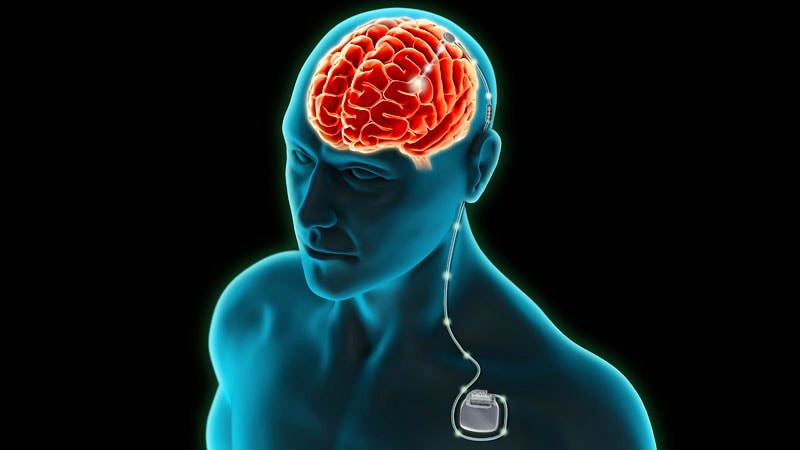The study covered in this summary was published on medRxiv.org as a preprint and has not yet been peer reviewed.
Key Takeaways
-
In a study of a longitudinal cohort of patients with Parkinson’s disease (PD) off therapy, the sequence effect was measured using best-fit decay of angular velocity, an objective metric of limb bradykinesia, and worsened over time off-therapy over 3 years.
-
The sequence effect improved during continuous, open-loop, subthalamic nucleus (STN) deep brain stimulation (DBS) in a dose-dependent manner.
-
Adaptive (closed loop) DBS using a neural controller provided even better treatment of the sequence effect.
Why This Matters
-
The sequence effect affects up to 90% of people with PD, worsens with disease progression, and causes significant morbidity. While many studies have demonstrated that dopaminergic medications do not improve the sequence effect in PD, this study looks at the sequence effect as a metric over time.
-
This study determined that an exponential fit best represented the sequence effect in time-series data for repetitive wrist flexion extension (rWFE) and was able to differentiate the sequence effect from other metrics like amplitude and frequency. The study was also able to describe epochs of sequence effect with an angular velocity trace.
-
Findings suggest STN DBS is a promising therapy to improve the sequence effect in bradykinesia for people with PD.
Study Design
-
This study involved 21 patients (5 women, 16 men) with clinically established PD. Each of these patients underwent bilateral implantation of DBS leads in the STN, and the DBS leads were connected to an investigative neurostimulator.
-
One participant was re-implanted with another investigative neurostimulator and completed the closed-loop study.
-
Data were collected during an rWFE task in three stimulation conditions: off stimulation, clinical open-loop stimulation, and neural closed-loop stimulation.
-
Experiments were conducted before activation of the DBS system, and off all therapy after 6 months, and then 1, 2, and 3 years after the initial visit in 6-month intervals. All experimental testing was done in the off-medication state. At follow-up visits, stimulation was turned off for 60-75 minutes, and participants performed rWFE as a measure of bradykinesia.
Key Results
-
The mean age of participants was 55 years and mean disease duration was 8.9 years.
-
At the initial visit of the longitudinal off-stimulation study, of 21 patients and 42 hands, 25 hands showed only one epoch of sequence effect and 17 exhibited multiple epochs. Across the 21 participants throughout 3 years of repeat visits, 134 trials showed one epoch of sequence effect and 78 trials showed multiple epochs.
-
After performing the rWFE task off therapy, at up to 7 timepoints out to 3 years after the initial programming visit, the sequence effect worsened over time (β = 0.0453; P = .00037).
-
Increasing intensities of STN DBS during rWFE were associated with a decrease in sequence effect. [F(4,60) = 3.01; P = .0233]. Additionally, DBS progressively reduced sequence effect, with differences occurring at STN DBS at 75% and 100% Vmax.
-
Finally, closed-loop DBS further improved the sequence effect from clinical open-loop DBS in 8 out of 10 closed loop DBS conditions across various delay periods.
Limitations
-
The experiments were all performed off medication and results could not conclude whether medication improved the sequence effect as calculated.
-
Correlations with bradykinesia and MDS-Unified Parkinson’s Disease Rating Scale – motor subscale (MDS-UPDRS III) were performed before activation of DBS.
-
A cumulative effect of increased dose DBS could have affected results.
Disclosures
-
Medtronic PLC provided devices but no financial support.
-
Helen Bronte-Stewart serves on the clinical advisory board for Medtronic PLC.
This is a summary of a preprint research study, “The Sequence Effect Worsens over Time in Parkinson’s disease and Responds to Open and Closed-Loop Subthalamic Nucleus Deep Brain Stimulation,” written by researchers at the Stanford University School of Medicine, Department of Neurology and Neurological Sciences, Department of Neurosurgery, Stanford, California on medRxiv, provided to you by Medscape. This study has not yet been peer reviewed. The full text of the study can be found on medRxiv.org.
For more news, follow Medscape on Facebook, Twitter, Instagram, YouTube, and LinkedIn
Source: Read Full Article
